
A report by Lars Pettersson FSF
Let it be said once and for all, that the 6th edition of the ODCC was a highly rewarding experience, especially for anyone interested in feature film cinematography, since it boasted no fewer than two masterclasses with high-ranking cinematographers Luciano Tovoli ASC, AIC and Luca Bigazzi AIC. As is their habit, IMAGO and the FNF, under the competent leadership of messieurs Paul René Roestad, FNF, and Rolv Håan, FNF, respectively, put on a well-oiled and excellent three-day conference.
Compared to the conference held two years ago, there has also been a pleasant evolution in terms of equality, in 2015 all speakers were exclusively male, but this time around at least three of the presentations were held by female experts. As is customary, the ODCC is held in the excellent facilities belonging to the Norwegian Film Institute situated on Dronningens Gate in downtown Oslo , just a stone’s throw from the central train station with its direct shuttle to the airport.
The seats in the film Institute’s Cinema are rapidly filled with participants perhaps mainly from Europe, but also from Australia, the US and many other corners of the world. After a short introductory speech from the President of IMAGO, Paul René Roestad, FNF, the conference is off to a flying start with three camera presentations in a row: The Canon C700, the Panasonic Varicam and the brand-new Sony Venice.
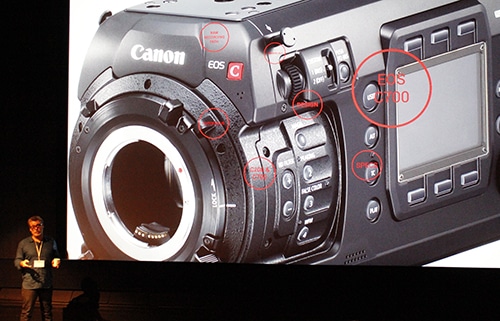 British cinematographer Brett Danton recounts his experiences with the Canon C700 while shooting a Range Rover commercial in the remote Australian outback. He emphasizes how quickly you can work with this camera -in only seven hours they managed to shoot two full commercials! The fact that the camera house has built in “cheese plates” both on top and below, means that you can very quickly mount it on, say for instance, a “shot over” helicopter mount. Danton also had a Canon C200 as B-camera, and since both models use the same sensor they work very well together.
British cinematographer Brett Danton recounts his experiences with the Canon C700 while shooting a Range Rover commercial in the remote Australian outback. He emphasizes how quickly you can work with this camera -in only seven hours they managed to shoot two full commercials! The fact that the camera house has built in “cheese plates” both on top and below, means that you can very quickly mount it on, say for instance, a “shot over” helicopter mount. Danton also had a Canon C200 as B-camera, and since both models use the same sensor they work very well together.
The next presentation is ’Next Generation Imaging and the Impact of HDR’ and is held by Dave Stump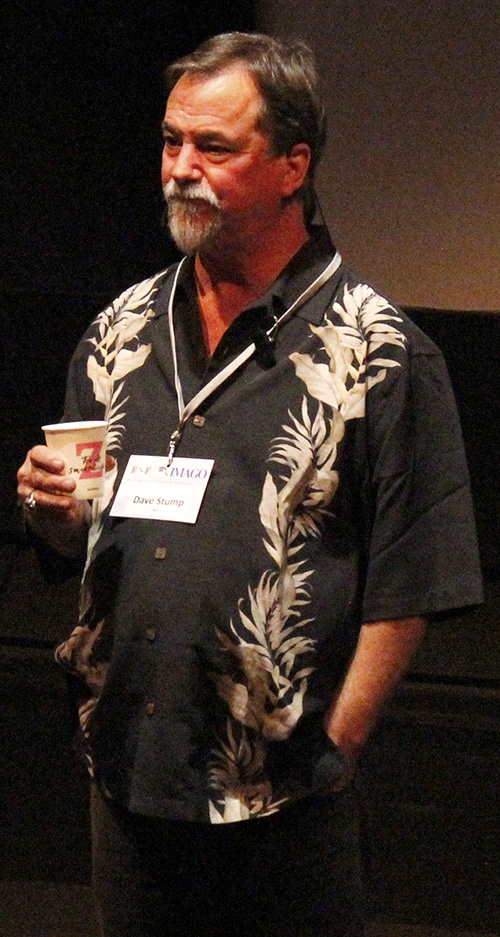 ASC. HDR means we now must be more careful on the set than ever before. You should pan more slowly, and you can get unpleasant surprises concerning wigs and make-up effects -joins you’re used to “getting away with” now suddenly show up clearly in dailies. You should also monitor the entire workflow from set to postproduction, so there’s no loss of data. HDR means presenting much more visual information than we’re used to – if it has been unintentionally compressed during the workflow, you can end up with terrible artifacts.
ASC. HDR means we now must be more careful on the set than ever before. You should pan more slowly, and you can get unpleasant surprises concerning wigs and make-up effects -joins you’re used to “getting away with” now suddenly show up clearly in dailies. You should also monitor the entire workflow from set to postproduction, so there’s no loss of data. HDR means presenting much more visual information than we’re used to – if it has been unintentionally compressed during the workflow, you can end up with terrible artifacts.
Sony Venice
Then Sony unveils its brand-new Sony Venice camera -and you get an idea how new this camera is when you hear it won’t be possible to buy it until February 2018! The actual camera that Sony is showcasing here at the ODCC, is one out of only half a dozen working prototypes in existence. But the ideas behind this camera are impressive. For starters, the camera’s sensor block is interchangeable -along the lines of a traditional motion picture camera, where you can change raw stock.
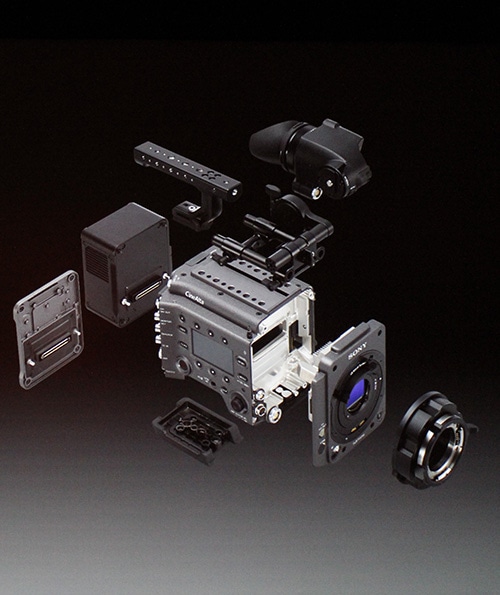
This is something which Vittorio Storaro ASC AIC has expressed a wish for in interviews, and it appears Sony liked the idea. We’re talking about a brand-new 24’36 sensor, and also the camera’s PL-mount can be easily removed and underneath there’s an E-mount -meaning that the camera can handle almost any lens you might wish to use.
(There’s a 24-page in-depth report on the Sony Venice in Jon Fauer’s Film & Digital Times, for those who wish to know more! (http://www.fdtimes.com/2017/09/06/sony-venice/
Behind the headline ’High Dynamic Range for Cinema Screens’, the -by a wide margin- best-looking images to be seen during the entire conference were revealed! Cédric Lejeune from Éclair-color was responsible for this presentation, and you might say that Éclair-color have taken a page out of the same book used by George Lucas for the THX certification of cinemas some thirty years ago, since their product really consists of a series of specifications for every parameter along the post production workflow, from color correction right down to what gain the cinema screen should be. A picture says more than a thousand words, and that certainly holds true for the Éclair-color demo film, which is truly impressive! Éclair-color specifies 30 foot Lamberts rather than 14, and the result is brighter, more detailed highlights in combination with vivid colors and rich blacks -what more could you ask for? Using 1,8 gain white screens, Éclair-color can handle screen sizes up to 60 feet, and they do have one of those installed right now in Nuremberg, Germany.
Next, cinematographer Matthias Bolliger tells us about his work with the Panasonic Varicam, with it’s dual-native 800/5000 ISO sensor. Bolliger in fact showed us night exterior footage taken with moonlight as the only light source. By and large one gets the impression that both Canon and Sony recently have taken some inspiration from the Varicam, and particularly the Varicam LT, regarding the form factor.

Next on the program is a master class with legendary Italian cinematographer Luciano Tovoli, ASC AIC . One quickly realizes that an hour is no time at all for a legendary raconteur of this caliber! The stories and anecdotes abound, and Tovoli frequently brings down the house. You quickly realize we’re only scratching the surface here, but among the highlights are excerpts from an early black-and-white documentary about criminal peasants in the mountains close to Rome, an amazing documentary shot in China with Antonioni as director -and Antonioni doesn’t want Tovoli to shoot anything at all, the famous director much prefers to spend the time with his new girlfriend, 35 years his junior. And of course the more than six minutes long penultimate shot in Antonioni’s ’The Passenger’ (1975)!
The FNF then offers a drink in the bar before screening the Antonioni feature film ’The Passenger’ starring Jack Nicholson and Maria Schneider .
Saturday, the first lecture was on a subject often overlooked: the cinematographer’s right to financial compensation for his work. Voices from the audience bore witness to the fact that although cinematographers in many countries on principle have a right to additional financial compensation when their work is shown, does not often happen. This is not the case in Norway, we learn, as Björn Alexander Brem from the organization FOR tells us how they have successfully managed to arrive at a satisfactory solution in the Norwegian media industry. The key, Brem stresses, lies in ‘bargaining power’, simply put collective strength through organizations like the FNF and others. In short, the producer of a successful motion picture (for instance) pays a lump sum to FOR, which in return pays out the correct amount of money to each individual (director, scriptwriter, cinematographer etc).
Philippe Ros, AFC , under the headline ’Creative Cinematography and Camera Control’ explored the concept of ’texture’ -what do we mean by that and what parameters affect it? We are now using 4K cameras and on principle they will all give the same 4K resolution, but some have 20 million photosites, and others have less than eight, on their sensors -resulting in different impressions of sharpness and image quality.
Rolf Coulanges, BVK, demonstrated how ACES came to the rescue when re-scanning a 30 year old documentary about Brazilian musicians. To make a long story short, the combination of ACES and the ARRISCAN brought out additional detail in the shadows, almost as if you had had a much faster raw stock when shooting the film in the first place, 30 years ago!
The last presentation before the lunch break was by Dr Tamara Seybold from ARRI, who specializes in Motion Picture Camera Denoising , and the result of her research can be found in the AMIRA- and SXT-cameras. Her lecture was a combination of an explanation how a digital sensor operates and a chance for the audience to directly give input what possibilities to influence the image they would like to see in future ARRI cameras -a very valuable opportunity to influence the ARRI products of tomorrow!
True to form, the ODCC offers delicious sandwiches during the lunch hour, and then Alex Forsythe from AMPAS, the American Motion Picture Academy, explains to us what ACES is. Basically it’s a set of standards to safeguard that the material you recorded on the set survives at the highest possible level of quality until they reach their audience. For instance, ACES aims to preserve dynamic range in your source material so there is no loss of data in the workflow. Another important field for ACES is archive material, which sometimes today can be of subpar quality. It’s also vitally important that archive material makes sense to, and is easily understood by, whomever wishes to create a new version of a film 25 years into the future.
There were two more presentations before it was time for a short coffee break. The first of these was ’Colour Appearance and Preferred Colour Reproduction’ and Daniele Siragusano from the company FilmLight began with a comparison between the 100 year evolution of the photochemical image with its digital counterpart, and pointed out that the evidence suggests no system based on three colors can yield perfect color reproduction. Then he demonstrated how totally different a digital sensor reacts to light (linearly) compared to the human eye (logarithmically) and how prone human perception is to error when assessing colors and contrasts, all fascinating stuff!
’Lens Challenges in Large Format Cinematography’ was presented by Daniela Kesselem from CW Sonderoptiks, a sister company of Leica Camera AG,  founded in 2008. Leica decided a few years ago that they wanted to introduce lenses for the motion picture industry, and the Thalia lenses are the CW Sonderoptik premium product in the ’Large Format Cinematography’ range. Daniela Kesselem proceeded to explain all the design advantages gained by larger lenses, for instance it’s technically easier to design wide angle lenses when dealing with a larger sensor. These larger sensors also allow longer focal lengths, and Leica feel that you quite frankly get the best of both worlds (short and long focal lengths) this way, two important points being the shallow depth of field and the more flattering reproduction of faces in portrait compositions.
founded in 2008. Leica decided a few years ago that they wanted to introduce lenses for the motion picture industry, and the Thalia lenses are the CW Sonderoptik premium product in the ’Large Format Cinematography’ range. Daniela Kesselem proceeded to explain all the design advantages gained by larger lenses, for instance it’s technically easier to design wide angle lenses when dealing with a larger sensor. These larger sensors also allow longer focal lengths, and Leica feel that you quite frankly get the best of both worlds (short and long focal lengths) this way, two important points being the shallow depth of field and the more flattering reproduction of faces in portrait compositions.
Opportunities and pitfalls when producing a VR drama series for Norwegian television were accounted for by Svend Even Herra, FNF, who showed us examples from the VR drama series ’jenter’ (Girls) evolving around a group of teenage high school girls and their adventures, and also a pretty spectacular sequence showing a ski jump from the point of view of the skier!
Jannicke Mikkelsen FNF, a London-based cinematographer and VR director, educated at the National Film School in Great Britain, next gave a highly entertaining lecture, with lots of humor and unexpected twists, simply a good example of when reality surpasses fiction.
After finishing her education as a stereographer (3D cinematography expert) she receives an amazing offer to work for sir David Attenborough on a nature documentary -but it turns out this is a virtual-reality production and does not require a stereographer at all. No problem, Jannicke is hired anyway and quickly learns what she needs to know about VR. Having made the acquaintance of Sir David leads her further into the realm of science, among astronomers and physicists… and 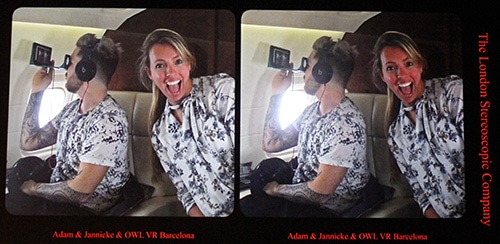 one of these scientists is Dr. Brian May, who besides his career in astrophysics… also happens to be the lead guitarrist in the rock group Queen! Brian May asks Jannicke Mikkelsen if she could help him create something spectacular for Queen’s new world tour, which is scheduled to hit the road presently. She’s happy to help out if she can and asks May what he has in mind. ‘we’d like you to film the concert as a 360° VR and 3D experience where you get the feeling of floating around in a spaceship’ is the answer.
one of these scientists is Dr. Brian May, who besides his career in astrophysics… also happens to be the lead guitarrist in the rock group Queen! Brian May asks Jannicke Mikkelsen if she could help him create something spectacular for Queen’s new world tour, which is scheduled to hit the road presently. She’s happy to help out if she can and asks May what he has in mind. ‘we’d like you to film the concert as a 360° VR and 3D experience where you get the feeling of floating around in a spaceship’ is the answer.
To make a long story short, Jannicke Mikkelsen succeeds against all odds with her mission and we in the audience are treated to short sequence from this truly unique concert movie.
What will it take for film educators wishing to embrace and teach all the new narrative technologies that surround us right now? That was the focus for the lecture ’Educating Filmmakers… for VR?’, and Fredrik Graver from Den Norske Filmskolen listed all the challenges and opportunities facing educators, not least when it comes to 3D and VR. Den Norske Filmskolen have a very ambitious agenda and have recently hired two researchers and are also welcoming collaborations with international institutions in this field.
The Saturday program was rounded off with yet another screening of a feature film, this time the Oscar winner ’La Grande Belleza’ (2013) directed by Paolo Sorrentino and shot by Luca Bigazzi, AIC. It’s such a treat to watch a film in the Norwegian Film Institute’s cinema that you completely forget you’ve already spent the entire day in a cinema seat, the projection it’s superb, showcasing the beautiful imagery and the cinematography of Bigazzi. There’s a brief Q&A with Luca Bigazzi after the movie, and then we all board chartered buses taking us to the facilities of rental house Storyline for dinner and party.
Sunday morning it was somehow much easier to find empty seats in the cinema -it may have had something to do with the party the night before… The first presentation was very interesting, however, Gunnleik Groven introduced the handy little black box Quinebox IoT, dedicated to keeping track of all meta-data during a production. Groven explained that he just finished a shoot in China, where he was told that ‘we’re not particularly interested in meta-data in China’ but in the next breath they very much wanted to know what the T-stop, focal length and timecode were on that last take… Meta-data has an unfortunate tendency to frequently go missing in today’s workflow, and the Quinebox IoT is a sure-fire cure for this.
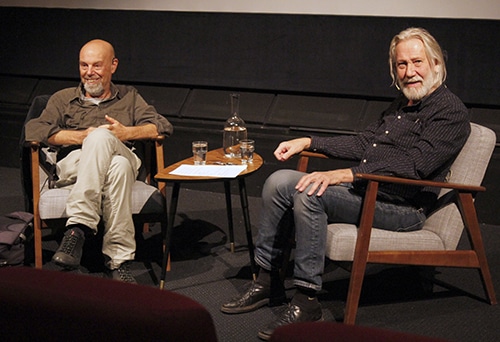 During Groven’s lecture the auditorium gradually begins to fill up, because no one wants to miss out on what’s next on the program: a Masterclass with the Italian cinematographer Luca Bigazzi, AIC. With Rolv Håan, FNF, handling the interview the situation is in safe hands, and the conversation tends understandably to emphasize ’La Grande Belleza’ and the long collaboration with Paolo Sorrentino. We learn that Luca Bigazzi prefers a stressful situation rather than a relaxed set, he enjoys being forced by circumstances to adapt quickly. He doesn’t like photochemical film, handheld cameras, large depth of field in close-ups of actors faces, and he is appalled that people today watch movies on their cell phones and laptops -film should be seen in a cinema! He loves digital cameras -especially the Red Weapon- and enjoys using cranes, steadicams and multi-camera setups. Luca Bigazzi is also very pleased that Italian cinema is in good shape right now, every year there are at least 5 – 10 new movies that’s he really enjoys, and this has not always been the case.
During Groven’s lecture the auditorium gradually begins to fill up, because no one wants to miss out on what’s next on the program: a Masterclass with the Italian cinematographer Luca Bigazzi, AIC. With Rolv Håan, FNF, handling the interview the situation is in safe hands, and the conversation tends understandably to emphasize ’La Grande Belleza’ and the long collaboration with Paolo Sorrentino. We learn that Luca Bigazzi prefers a stressful situation rather than a relaxed set, he enjoys being forced by circumstances to adapt quickly. He doesn’t like photochemical film, handheld cameras, large depth of field in close-ups of actors faces, and he is appalled that people today watch movies on their cell phones and laptops -film should be seen in a cinema! He loves digital cameras -especially the Red Weapon- and enjoys using cranes, steadicams and multi-camera setups. Luca Bigazzi is also very pleased that Italian cinema is in good shape right now, every year there are at least 5 – 10 new movies that’s he really enjoys, and this has not always been the case.
After a lunch break once again featuring the ODCC trademark delicious sandwiches, only two presentations remain. Bendik Bryde from the company PIQL introduces their ingenious long-term archiving concept: they photograph onto a 35 mm filmstrip everything needed for optimum long-term archiving. If we’re dealing with a still image, one frame is dedicated to this image so that anyone could identify it with the naked eye, the next
frame is loaded with digital code to enable reproduction of this image at maximum qualtity. But they go even further than this. Not only do they archive images, sounds and videos in this way, they also provide -on this very same filmstrip- everything that future generations will need to re-create the machines on which to play this media. No longer do we need to preserve a physical specimen of, say a particular computer -future generations can simply build one of these computers by following the instructions on the film strip!
And the advantages of the PIQL solution go on: migration of digital media from one carrier to the next is a huge problem, and this can be side-stepped entirely(!) with this method: the strip of film will safely preserve its contents by simply remaining on its shelf for 500 years. And as if this wasn’t enough, PIQL stores the material on the island of Svalbard near the North Pole, protected by permafrost and dangerous polar bears. If you have your material here you should be able to sleep well at night.
The conference was rounded off with a plea from the technical committee of IMAGO -represented by ROLF COULANGE, BVK, JOHN CHRISTIAN ROSENLUND FNF, PHILIPPE ROS, AFC AND MICK VAN ROSSUM, NSC- to manufacturers of cameras and display hardware. We need a standardisation of concepts and expressions in the field of digital video, much in the same way that already exists, for instance, in the field of it aviation. ‘Take off’ and ‘landing’ mean the same thing across the globe, but when it comes to concepts like ‘sharpness’ or ‘debayering’ in digital video there exists no such standardisation. The committee listed a number of such areas and situations where much work remains to be done, before it was time for Paul René Roestad, FNF, to receive well-deserved applause for a well-executed and memorable conference.


























